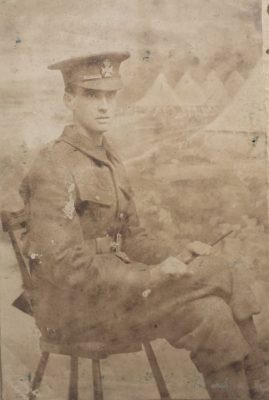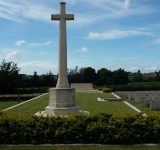Personal Details
George Harold Groom was born in Hanmer, Flintshire in 1897, the eldest son of Levi and Elizabeth Groom of Horseman’s Green, near Whitchurch Shropshire.
Military History
Regiment : 21st Battalion King’s Royal Rifle Corps
Rank : Rifleman
Service Number : R/33490
Died of wounds; France 21 September 1917 Aged 20
George landed in France 11th November 1916. In January 1917 he was invalided home with trench fever, returning to the front in July 1917. He was wounded on 20th September 1917, dying from his wounds.
George was awarded the Campaign Medals (British War Medal and Allied Victory Medal).

The British War Medal (also known as 'Squeak') was a silver or bronze medal awarded to officers and men of the British and Imperial Forces who either entered a theatre of war or entered service overseas between 5th August 1914 and 11th November 1918 inclusive. This was later extended to services in Russia, Siberia and some other areas in 1919 and 1920. Approximately 6.5 million British War Medals were issued. Approximately 6.4 million of these were the silver versions of this medal. Around 110,000 of a bronze version were issued mainly to Chinese, Maltese and Indian Labour Corps. The front (obv or obverse) of the medal depicts the head of George V. The recipient's service number, rank, name and unit was impressed on the rim.
The Allied Victory Medal (also known as 'Wilfred') was issued by each of the allies. It was decided that each of the allies should each issue their own bronze victory medal with a similar design, similar equivalent wording and identical ribbon. The British medal was designed by W. McMillan. The front depicts a winged classical figure representing victory. Approximately 5.7 million victory medals were issued. Interestingly, eligibility for this medal was more restrictive and not everyone who received the British War Medal ('Squeak') also received the Victory Medal ('Wilfred'). However, in general, all recipients of 'Wilfred' also received 'Squeak' and all recipients of The 1914 Star or The 1914/1915 Star (also known as 'Pip') also received both 'Squeak' and 'Wilfred'. The recipient's service number, rank, name and unit was impressed on the rim.
Further Information
More information about George Harold Groom is available from Flintshire War Memorials.
If you can provide any further information on George Harold Groom please get in touch by leaving a comment below, using our Contact Form or by calling in to Whitchurch Heritage Centre.
Information provided by Whitchurch Museum and Archives


